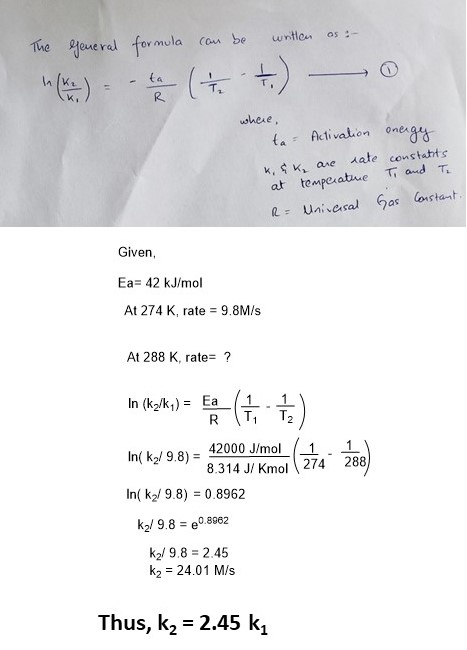A certain reaction is known to have an activation energy E=42.0 kJ/mol. Furthermore, the rate of this r measured at 274. K and found to be 9.8M/s. Use this information to answer the questions in the table be Suppose the concentrations of all reactants is kept the same, but the temperature is raised by 5% from 274. K to 288. K. How will the rate of the reaction change? Suppose the concentrations of all reactants is kept the same, but the catalyst is added, which has the effect of lowering the activation energy by 10%, from 42.0 kJ/mol to 37.8 kJ/mol. How will the rate of the reaction change? The rate will The rate will ✓ choose one stay the same rise about 5% rise more than 5% rise less than 5% fall about 5% fall more than 5% fall less than 5% X
A certain reaction is known to have an activation energy E=42.0 kJ/mol. Furthermore, the rate of this r measured at 274. K and found to be 9.8M/s. Use this information to answer the questions in the table be Suppose the concentrations of all reactants is kept the same, but the temperature is raised by 5% from 274. K to 288. K. How will the rate of the reaction change? Suppose the concentrations of all reactants is kept the same, but the catalyst is added, which has the effect of lowering the activation energy by 10%, from 42.0 kJ/mol to 37.8 kJ/mol. How will the rate of the reaction change? The rate will The rate will ✓ choose one stay the same rise about 5% rise more than 5% rise less than 5% fall about 5% fall more than 5% fall less than 5% X
Chemistry
10th Edition
ISBN:9781305957404
Author:Steven S. Zumdahl, Susan A. Zumdahl, Donald J. DeCoste
Publisher:Steven S. Zumdahl, Susan A. Zumdahl, Donald J. DeCoste
Chapter1: Chemical Foundations
Section: Chapter Questions
Problem 1RQ: Define and explain the differences between the following terms. a. law and theory b. theory and...
Related questions
Question

Transcribed Image Text:A certain reaction is known to have an activation energy E=42.0 kJ/mol. Furthermore, the rate of this reaction is
measured at 274. K and found to be 9.8M/s. Use this information to answer the questions in the table below.
Suppose the concentrations of all reactants is
kept the same, but the temperature is raised by
5% from 274. K to 288. K.
How will the rate of the reaction change?
Suppose the concentrations of all reactants is
kept the same, but the catalyst is added, which
has the effect of lowering the activation energy
by 10%, from 42.0 kJ/mol to 37.8 kJ/mol.
How will the rate of the reaction change?
The rate will
The rate will
✓ choose one
stay the same
rise about 5%
rise more than 5%
rise less than 5%
fall about 5%
fall more than 5%
fall less than 5%
?
00.
Ar
Expert Solution
Step 1

the rate will rise by more than 5 % on increasing the temperature from 274 K to 288 K.
Trending now
This is a popular solution!
Step by step
Solved in 2 steps with 1 images

Knowledge Booster
Learn more about
Need a deep-dive on the concept behind this application? Look no further. Learn more about this topic, chemistry and related others by exploring similar questions and additional content below.Recommended textbooks for you

Chemistry
Chemistry
ISBN:
9781305957404
Author:
Steven S. Zumdahl, Susan A. Zumdahl, Donald J. DeCoste
Publisher:
Cengage Learning

Chemistry
Chemistry
ISBN:
9781259911156
Author:
Raymond Chang Dr., Jason Overby Professor
Publisher:
McGraw-Hill Education

Principles of Instrumental Analysis
Chemistry
ISBN:
9781305577213
Author:
Douglas A. Skoog, F. James Holler, Stanley R. Crouch
Publisher:
Cengage Learning

Chemistry
Chemistry
ISBN:
9781305957404
Author:
Steven S. Zumdahl, Susan A. Zumdahl, Donald J. DeCoste
Publisher:
Cengage Learning

Chemistry
Chemistry
ISBN:
9781259911156
Author:
Raymond Chang Dr., Jason Overby Professor
Publisher:
McGraw-Hill Education

Principles of Instrumental Analysis
Chemistry
ISBN:
9781305577213
Author:
Douglas A. Skoog, F. James Holler, Stanley R. Crouch
Publisher:
Cengage Learning

Organic Chemistry
Chemistry
ISBN:
9780078021558
Author:
Janice Gorzynski Smith Dr.
Publisher:
McGraw-Hill Education

Chemistry: Principles and Reactions
Chemistry
ISBN:
9781305079373
Author:
William L. Masterton, Cecile N. Hurley
Publisher:
Cengage Learning

Elementary Principles of Chemical Processes, Bind…
Chemistry
ISBN:
9781118431221
Author:
Richard M. Felder, Ronald W. Rousseau, Lisa G. Bullard
Publisher:
WILEY